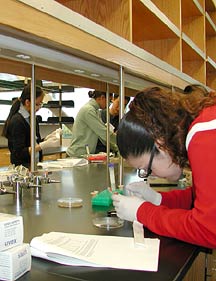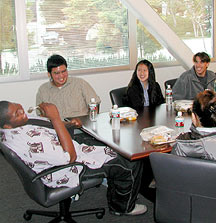"The Race is So On":
Next Generation of Scientists Find Their Stride at TSRI
By Jennifer O'Sullivan
Two participants of the Spring Enrichment Tutorials at The Scripps Research
Institute (TSRI)—Claudia Hernandez, a senior at Chula Vista High
School, and Marvin Hamlin, a junior at the San Diego School of Creative
and Performing Arts—are going head-to-head. Both claim that someday
they will cure cancer.
"The race is on," says Hernandez. "It is so on!"
Call it youthful arrogance or youthful exuberance, the 18 high school
students accepted into TSRI's High School Research Education Program have
got it and TSRI's program gives focus to their ambition. Throughout April
and May, these students will participate in weekly tutorials on aspects
of modern cellular and molecular biology and chemistry.
The young participants were selected from a large pool of applicants
by Vice President of Communications Robin Clark (formerly Goldsmith);
Program Coordinator Jennifer O'Sullivan; and representatives from the
Neighborhood House Association (which administers funds from the San Diego
Workforce Partnership). The program's other funding sources include the
Hearst Foundation and the French Fund, administered by Wells Fargo Bank.
TSRI doctoral candidates teach the tutorials, which challenge the students
at a level that matches their aspirations. The combinatorial chemistry
tutorial, for example, was designed by doctoral candidates Scott Wolkenberg
and Andrew Su. With Su graduating in May and Wolkenberg to follow, second-year
graduate students Brendan Crowley and Byron Purse are taking up the combinatorial
chemistry lab torch.
"The purpose of the [April 27] lab is to demonstrate the fundamentals
of combinatorial chemistry as it is applied to drug discovery," says Purse.
"We wanted to illustrate how known mixtures of candidate compounds can
be prepared employing reliable chemical linking strategies and [then show
students] how these mixtures could be screened for a specific activity,
in this case antibiotic."
In the lab exercise, three aldehydes are reacted with three hydrazines
to form nine hydrazones in known mixtures. This is the combinatorial library.
One of the resulting compounds, guanofuracin, is a known antibiotic. After
carrying out the reactions, students inoculate agar plates with a broth
culture of E. coli and bore cups in the plates with the large end
of a glass pasteur pipet. A few drops from each mixture of compounds are
then placed in each cup. After incubating the plates overnight, a bacterial
lawn develops, leaving a clear plaque around any cup containing a compound
with antibiotic activity.
"The students did really well," Purse reports. "They were really enthusiastic
about it and actually finished faster than we expected. They haven't seen
the results yet, but nearly all of the plates look perfect."
Students will be able to observe the plates next Wednesday during the
"Drug Development & Diseases" class. Crowley and Purse will show them
how the results are deconvoluted and the active compound "discovered."
"We do lab experiments at school, but not with E. coli," Marvin
Hamlin observes. "I was able to understand the lab preparation, protocol,
and procedure. And you know, I didn't come home with green fingers."
They Learn Something New Every Week
In addition to combinatorial chemistry, other topics covered during
the Spring Enrichment Tutorials include HIV, forensics, mass spectrometry,
cells, and microscopy. Classes entitled "Grants & Money" and "Policy,
Ethics & Current Events," in which students discuss difficult policy decisions
regarding stem cell research and the allocation of anti-HIV drugs in developing
countries, give high school students much to think about. The myriad topics
also stimulate the students' ideas about areas they might like to work
in during the more deliberate, focused summer internship—the second
part of the program.
"After the HIV class I really wanted to do work on the human immunodeficiency
virus," says Claudia Hernandez. "But then after Mike [Dorrell, graduate
student and tutorial coordinator] talked about angiogenesis on Saturday,
I might like to work on something related to that instead. I guess I want
to do everything!"
For graduate students like Dorrell who choose to participate in the
tutorials, the opportunity to expose high school students to current research
and contemporary issues in science is truly rewarding. "It's great to
see how excited they get about science," Dorrell says. "And interacting
with graduate students provides them with a glimpse of what their academic
futures will hold."
Hernandez weighs in with the students' perspective. "The instructors
are so educated and well-versed in their fields," she says. "They never
have that look [that says], 'please don't ask me any questions!'"
Hamlin adds, "I love working with the grad students because it shows
the kind of dedication one needs to be a good scientist."
Speaking of the pursuit of good science, what does Hamlin think of the
fact that Hernandez—soon-to-be microbiology student at the University
of California at Santa Barbara and his competition in the quest to cure
cancer—will be leaving for college a full year before he does?
"Head starts don't mean everything," he responds. "I'll be catching
up soon, and when I do find my cure for cancer I'll be sure to let everyone
know that I once worked at The Scripps Research Institute."
Ah, youth. Must be spring again!
Link:
For the combinatorial chemistry lab that TSRI graduate students Scott
Wolkenberg and Andrew Su designed for high school students, see their
publication in the Journal
of Chemical Education, 2001, 78, 784.
Go back to News & Views Index
|

Lincoln High School student Karina Garcia (front)
prepares an agar plate during the combinatorial chemistry lab at a recent
spring enrichment tutorial. In the background, Andrew Su, who helped design
the lab, assists Helix Charter School student Amy Leff (middle) and Mission
Bay High School student Bich Tran (far left). Photo by
Jennifer O'Sullivan.

Typical results from the lab: agar plates grown
overnight are covered by a lawn of bacteria except for areas surrounding
antibiotic compounds.

Marvin Hamlin (far left) enjoys a break during the
Saturday spring enrichment tutorial along with (clockwise) Reinhart Arquiza,
Bich Tran, Mike Dorrell, and Angel Nguyen. Photo by Jennifer
O'Sullivan.
|



